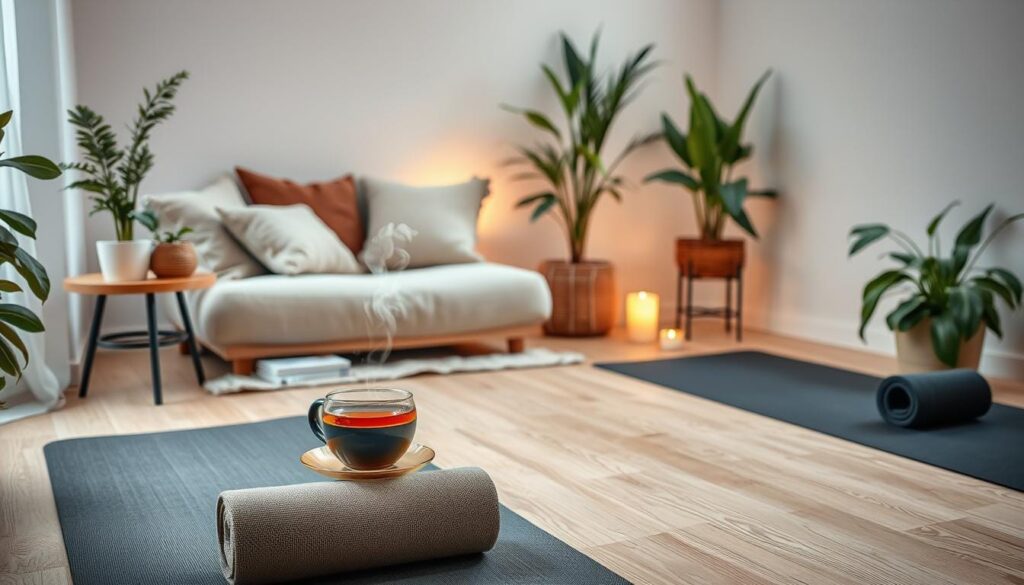Worry can feel like a heavy weight, something many people carry every day. This is because of Generalized Anxiety Disorder (GAD). Knowing you’re not alone is important. Millions worldwide deal with constant worry and anxiety, which can affect all parts of your life.
Recognizing GAD symptoms is the first step to taking back control. Symptoms like restlessness, fatigue, and trouble sleeping can be tough to handle. But, with the right help, you can manage these symptoms and improve your well-being.
Key Takeaways
- Generalized Anxiety Disorder (GAD) is a common mental health condition affecting millions worldwide.
- GAD is characterized by persistent, excessive worry and anxiety that can significantly impact daily life.
- Symptoms of GAD include restlessness, fatigue, difficulty concentrating, irritability, muscle tension, and sleep disturbances.
- Treatment options for GAD often involve a combination of medication and therapy, particularly Cognitive Behavioral Therapy (CBT).
- Adopting lifestyle changes, such as regular exercise, a balanced diet, and relaxation techniques, can also be effective in managing GAD symptoms.
What is Generalized Anxiety Disorder (GAD)?
Generalized Anxiety Disorder (GAD) is a mental health issue. It makes people worry too much about many things, like work, family, health, and money. This worry is more than what’s normal and can really mess up daily life.
People with GAD often think the worst will happen. They feel anxious even when there’s no real reason to. This can make life very hard.
Definition of GAD
GAD is a long-term condition. It’s marked by constant worry, tension, and fear. The anxiety disorders linked to GAD make people worry too much about things that aren’t really scary.
Those with GAD often feel stressed and anxious all the time. This stress and anxiety can make it hard for them to do everyday things.
Severity and Prevalence
GAD is a common mental health issue. It affects about 2% of adults in the U.S. and Europe each year. Over their lifetime, 3-5% of people will have GAD.
Interestingly, more women than men get GAD. This shows that gender might play a role in who gets this condition.
Risk Factors
- Genetics and family history of mental health issues
- Brain chemistry imbalances, such as neurotransmitter dysregulation
- Stressful or traumatic life events
- Chronic medical conditions that contribute to anxiety disorders
- Substance abuse or dependence
GAD can develop from many things. It’s a mix of biology, psychology, and environment. Knowing what increases the risk helps in preventing and treating GAD.
“Worry is a thin stream of fear trickling through the mind. If encouraged, it cuts a channel into which all other thoughts are drained.” – Arthur Somers Roche
Common Symptoms of GAD
Generalized Anxiety Disorder (GAD) makes you worry too much about many things. This worry affects your body, mind, and how you act. Knowing the signs of GAD can help you get help.
Physical Symptoms
- Muscle tension or aches
- Fatigue and lack of energy
- Difficulty sleeping or restless sleep
- Nausea, diarrhea, or other gastrointestinal issues
- Headaches or migraines
- Increased heart rate or palpitations
Emotional Symptoms
- Persistent feelings of fear, anxiety, or apprehension
- Irritability and short-tempered reactions
- Difficulty controlling worry or intrusive thoughts
- Sense of dread or impending doom
- Difficulty relaxing or feeling on edge
Cognitive Symptoms
- Difficulty concentrating or focusing on tasks
- Constant worrying about a variety of issues
- Overthinking and rumination
- Difficulty making decisions or problem-solving
- Intrusive, irrational thoughts or “what-if” scenarios
Behavioral Symptoms
- Avoidance of situations that may trigger anxiety
- Procrastination or difficulty completing tasks
- Restlessness and inability to sit still
- Excessive checking or reassurance-seeking behaviors
- Difficulty relaxing or enjoying leisure activities
Children with GAD might worry about the future, want to be perfect, and always need reassurance.
Knowing the signs of GAD can help you understand your feelings better. If you worry a lot, have panic attacks, or irrational fears, talk to a mental health expert. They can help you find the right treatment.
How GAD Symptoms Differ from Normal Anxiety
Feeling anxious sometimes is normal. But Generalized Anxiety Disorder (GAD) is different. It causes intense, frequent, and lasting stress and worry. This can really disrupt your daily life.
Comparison of Intensity
People with GAD worry a lot more than usual. They feel a constant fear or worry, even when there’s no reason to. This can make them very tired and upset.
Frequency of Symptoms
GAD symptoms last a long time, at least six months. They happen almost every day. This makes it hard to manage and affects your life a lot.
Impact on Daily Life
GAD can really mess up your daily life. It makes it hard to work, keep friends, or enjoy hobbies. The worry and anxiety can make you very tired and upset.
| Characteristic | Normal Anxiety | Generalized Anxiety Disorder (GAD) |
|---|---|---|
| Intensity of Worry | Mild to moderate | Intense and overwhelming |
| Frequency of Symptoms | Intermittent and manageable | Chronic and persistent |
| Impact on Daily Life | Minimal disruption | Significant disruption to work, relationships, and well-being |
Normal anxiety and GAD are different. GAD causes a lot of stress and worry that lasts a long time. It affects your daily life a lot. If you have GAD, you need help from a professional.
Recognizing GAD Symptoms in Yourself
Knowing the signs of generalized anxiety disorder (GAD) is key to managing it. GAD makes you worry too much and in a way that’s not rational. It can really mess up your daily life. By knowing the common signs, you can tell if your anxiety is getting out of hand.
Self-Assessment Techniques
Start by watching your thoughts and worries every day. See if you can’t stop worrying or if it’s making it hard to do things. Also, notice if you’re feeling tense, tired, or having trouble sleeping. These physical signs can show you’re anxious.
Journaling for Insight
Writing in a journal can help you understand your anxiety better. Write down your thoughts, feelings, and what makes you worry more. As you keep doing this, you might see patterns or things that make you anxious. This can help you learn more about your anxiety disorders and mental health.
Signs to Watch For
- Persistent, intrusive worries about a variety of topics, such as work, health, or family
- Difficulty controlling your irrational fears and anxious thoughts
- Physical symptoms like muscle tension, headaches, or digestive issues
- Difficulty concentrating or making decisions due to your worries
- Restlessness, irritability, or feeling on edge for most of the day
- Disruptions to your sleep patterns, such as trouble falling or staying asleep
If you see these signs a lot and for a long time, it’s time to get help. A professional can help you deal with your anxiety disorders and improve your life.

When to Seek Professional Help
If your anxiety is making it hard to live your daily life, it’s time to get help. Generalized Anxiety Disorder (GAD) makes you worry too much about many things. This can mess up your work, relationships, and happiness. Knowing when your anxiety gets too much is the first step to getting help.
Recognizing When Symptoms Escalate
Watch how often and how strong your worries and physical signs are. If you worry a lot about many things, feel tense, restless, or can’t sleep well, it’s a sign. When anxiety stops you from doing everyday things, it’s time to get help.
The Role of Mental Health Professionals
Therapists, psychologists, and psychiatrists are key in treating GAD. They can check how bad your symptoms are and find the best treatment. Cognitive-Behavioral Therapy (CBT) is a top choice for changing the thoughts and actions linked to GAD.
Finding the Right Support
- Look for mental health experts in your area who know about anxiety.
- Think about what you want, like the therapist’s style, gender, or if you prefer in-person or online sessions.
- Ask your doctor or local mental health centers for recommendations.
- Be ready to talk about your symptoms, health history, and any worries during your first meeting.
Getting help is brave and important for your mental health. With the right support and treatment, you can handle your anxiety and improve your life.
Co-occurring Conditions with GAD
Generalized Anxiety Disorder (GAD) often comes with other mental health issues. This mix of symptoms and challenges makes treatment harder. It’s key to understand these conditions to manage mental health well.
Depression
Depression often goes hand in hand with GAD. Both share symptoms like feeling tired, having trouble focusing, and feeling hopeless. It’s hard to tell them apart. But knowing both are present is vital for the right treatment.
Obsessive-Compulsive Disorder (OCD)
OCD and GAD can happen together. They both involve unwanted thoughts and actions. While they’re different, they both cause a lot of distress. It’s important to treat both for a person’s mental health.
Post-Traumatic Stress Disorder (PTSD)
PTSD and GAD can also occur together, especially after traumatic events. PTSD’s anxiety and being always on alert can make GAD worse. It’s crucial to see the link between these conditions for better care.
When GAD is paired with depression, OCD, or PTSD, a complete treatment plan is needed. This approach helps tackle the complex issues of anxiety disorders and mental health challenges.

The Impact of GAD Symptoms on Relationships
Generalized Anxiety Disorder (GAD) can really affect your relationships. It can change how you interact with your family and friends. You might worry too much, need constant reassurance, and find it hard to share your feelings.
This can make it tough to talk to others. You might not understand each other because of anxiety or trouble expressing your emotions.
Studies show that GAD can lead to divorce. People with GAD might find it hard to keep relationships strong over time. They might have few friends, struggle to show emotions, or feel scared and defensive in love.
Effects on Family Dynamics
GAD can make family life harder. A 2011 study found that kids with GAD might have fewer friends. But they can still have a best friend and join clubs.
A 2007 study said people with GAD might get married. But they could face problems in their relationships later on.
Communication Challenges
Talking well is key when you have anxiety disorders. A 2011 study found four ways people with GAD interact. Each style can affect relationships in different ways.
People with anxiety disorders might find it hard to stay in a relationship. They could end up single or get divorced more often.
Strategies for Maintaining Relationships
Having a strong support system is important for managing GAD. To keep relationships strong, talk openly about your mental health. Teach your loved ones about GAD and set clear boundaries.
Therapy, like cognitive-behavioral therapy, can help. It teaches you to reassure yourself instead of always relying on others during anxious times.
“Couples where one partner experiences anxiety disorders are 50% more likely to divorce.”
If GAD is affecting your relationships, get help from mental health experts. Call the Substance Abuse and Mental Health Services Administration (SAMHSA) National Helpline at 1-800-662-4357. They can provide information on support and treatment for anxiety disorders.
Managing GAD Symptoms Effectively
Living with generalized anxiety disorder (GAD) can be tough. But, there are ways to manage symptoms and feel better. By making lifestyle changes, practicing mindfulness, and getting professional help, you can see big improvements in your life.
Lifestyle Changes
Healthy habits can help with GAD. Try activities like brisk walking, swimming, or yoga to reduce anxiety. Eating well and getting enough sleep are also key. Lack of sleep can make anxiety worse.
Mindfulness and Meditation Techniques
Mindfulness and meditation are great for GAD. They help you stay in the present and reduce worries about the past or future. Meditation can calm your mind, improve emotional control, and bring peace.
Support Groups and Therapy
Connecting with others who have anxiety can be very helpful. Support groups, online or local, offer a place to share and get support. Cognitive Behavioral Therapy (CBT) can also change negative thought patterns that cause anxiety.
By using a mix of lifestyle changes, mindfulness, and therapy, you can take control of your GAD. This approach can improve your mental health, reduce anxiety’s impact, and enhance your life quality.

“Effective management of GAD involves a holistic approach that combines lifestyle changes, mindfulness techniques, and professional support. With the right tools and support, individuals with GAD can learn to better manage their symptoms and reclaim their well-being.”
Treatment Options for GAD
If you’re dealing with anxiety or mental health issues, you’re not alone. Generalized Anxiety Disorder (GAD) affects millions globally. There are effective treatments to help manage symptoms and improve well-being.
Cognitive Behavioral Therapy (CBT)
Cognitive Behavioral Therapy (CBT) is a top choice for GAD. It helps change negative thoughts that cause anxiety. With a therapist, you can learn to challenge and change these thoughts, finding better ways to cope.
Medication Options
Medication is also a key part of managing GAD. SSRIs, SNRIs, and benzodiazepines are common choices. Your doctor will pick the best medication based on your needs and health history.
Alternative Therapies
Some people find relief in alternative therapies like acupuncture, mindfulness, and herbal supplements. Always talk to a healthcare provider before trying new therapies. They can interact with medications or have side effects.
It’s vital to work with mental health professionals to create a treatment plan that fits you. With the right support and strategies, you can manage your anxiety and improve your life.
“More than 200 studies have shown that mindfulness-based cognitive therapy (MBCT) can be effective in easing anxiety.”
Lifestyle Adjustments to Alleviate Symptoms
Managing Generalized Anxiety Disorder (GAD) is not just about medical treatments. Making healthy lifestyle changes can really help. These changes include exercise, nutrition, and sleep hygiene. They can make other treatments work better and improve your overall health.
Exercise and Physical Health
Exercise is a strong tool against GAD symptoms. Studies show it can cut down anxiety symptoms by about 60%. Activities like walking, jogging, yoga, or swimming can boost mood and reduce stress.
Nutrition and its Importance
Eating well is key to managing anxiety. A diet full of complex carbs, fruits, veggies, and lean proteins can calm the mind and body. Stay away from too much alcohol, caffeine, and processed foods to avoid physical reactions.
Sleep Hygiene Practices
Good sleep habits are vital for GAD sufferers. Stick to a sleep schedule, relax before bed, and avoid screens at night. Quality sleep helps manage stress and anxiety.
Adding these lifestyle changes to your daily life can boost the impact of other treatments. Small, lasting changes can greatly support your mental health.
| Lifestyle Factor | Impact on GAD Symptoms | Recommended Adjustments |
|---|---|---|
| Exercise | Regular physical activity can reduce anxiety symptoms by up to 60%. | Engage in activities like walking, jogging, yoga, or swimming for at least 30 minutes per day. |
| Nutrition | A balanced diet rich in complex carbohydrates, fruits, vegetables, and lean proteins can support mental health. | Avoid excessive alcohol, caffeine, and processed foods that may trigger physical reactions. |
| Sleep Hygiene | Adequate, high-quality sleep is essential for managing mental health, chronic stress, and psychological distress. | Establish a consistent sleep schedule, practice relaxation techniques before bed, and avoid screen time close to bedtime. |

“Lifestyle changes such as better sleep, social support, stress-reduction techniques, and regular exercise can also help alleviate anxiety symptoms.”
Coping Strategies for Managing GAD Symptoms
People with generalized anxiety disorder (GAD) often find it hard to manage their worry. But, there are ways to ease anxiety symptoms and feel better. By using these strategies every day, you can handle anxiety better.
Breathing Exercises
Deep, diaphragmatic breathing is a strong tool against GAD symptoms. It’s also known as “belly breathing.” It can lower anxiety signs like a fast heartbeat and tight muscles. Doing deep breathing exercises a few times a day can calm you down and help you feel in control.
Time Management Techniques
Good time management can change things for GAD sufferers. Organizing tasks and focusing on what’s important can reduce stress. Try the Pomodoro method, make to-do lists, and learn to say no to things you don’t need to do.
Establishing Routines
Having regular routines can give you a sense of order and predictability. This is great for those with anxiety. Set a regular sleep schedule, exercise daily, and have morning and evening routines. These routines can be very comforting for people with GAD.
Remember, dealing with GAD is a journey, and what works for you might not work for others. Be patient, try different things, and get help if you need it to manage your anxiety.
The Importance of Self-Care in GAD
Managing Generalized Anxiety Disorder (GAD) needs a full approach, and self-care is key. Taking care of yourself is vital in facing anxiety’s challenges. By making a self-care plan, you can grow stronger, feel better mentally, and handle anxiety symptoms better.
Prioritizing Your Well-being
First, know and meet your personal needs. This might mean setting limits, saying no, and finding time for fun and calm. By doing this, you can handle daily life better and lessen anxiety disorders‘ effects.
Developing a Self-Care Plan
Creating a self-care plan that fits you is crucial. It could include hobbies, exercise, or mindfulness. Doing things that reduce stress and improve mood helps you face mental health issues like GAD better.
Activities that Promote Relaxation
- Reading a book or listening to calming music
- Practicing deep breathing exercises or meditation
- Engaging in creative pursuits, such as painting or journaling
- Spending time in nature, whether it’s a scenic hike or a peaceful garden
Adding these relaxing activities to your day can help you manage anxiety disorders and feel better overall.
Regular self-care helps you deal with GAD’s challenges more effectively. By focusing on your well-being, making a self-care plan, and doing relaxing things, you can actively manage your anxiety disorders and improve your life quality.
Support Systems for Individuals with GAD
Living with generalized anxiety disorder (GAD) can feel lonely. But, having a strong support system can really help. It’s important to have family, friends, and community resources to lean on.
Family and Friends Support
People close to you who get what you’re going through can offer a lot of emotional support. Talking openly about your feelings and needs helps them know how to help. Just listening, reassuring you, and helping out when you need it can make a big difference.
Community Resources
Many places have resources for those with anxiety disorders. Local support groups let you meet others who face similar issues. You can share tips and find comfort. Mental health organizations also offer workshops, counseling, and help finding the right professionals.
Online Support Networks
Online communities are great for mental health support, especially for GAD. You can find forums and social media groups where people understand your struggles. These spaces offer a sense of belonging and lots of helpful information.
Having a strong support network is key to managing GAD. By reaching out to family, friends, local resources, and online groups, you can better cope with your anxiety. This can greatly improve your life quality.
| Support Type | Key Benefits |
|---|---|
| Family and Friends | Emotional support, understanding, and practical assistance |
| Community Resources | Access to support groups, educational workshops, and mental health professionals |
| Online Support Networks | Connectivity, information sharing, and a sense of belonging |
“Seeking support and building a strong network can be transformative for individuals living with generalized anxiety disorder. No one should have to face these challenges alone.”
Staying Informed About GAD
It’s important to know about generalized anxiety disorder (GAD) to manage it well. If you or someone you care about has GAD, learning more can help. It lets you make better choices about treatment and how to cope.
Resources for Ongoing Education
Many trusted mental health groups and schools have lots of learning materials. You can find websites, webinars, and educational stuff. These offer the latest research and insights on GAD.
Books and Literature
Books by mental health experts can give you a deeper look at GAD. They talk about what causes it, its symptoms, and how to manage it. You’ll get useful knowledge and tools to help you.
Websites and Online Journals
Today, good websites and online journals are key for learning about anxiety and mental health. They share new research, expert views, and detailed guides. They help you stay updated and empowered.

Learning more about GAD can really help your mental health journey. By using trusted resources, you can learn more, find good ways to cope, and manage your anxiety. Knowledge is powerful, so start your journey of self-care today.
Conclusion: Living with GAD Symptoms
Living with Generalized Anxiety Disorder (GAD) is a journey that needs patience and self-compassion. It’s important to face challenges head-on and work hard to manage symptoms. Using daily reminders to cope, seeking support, and taking care of yourself can greatly improve your well-being.
Embracing Your Journey
Accepting GAD as part of your life can help you understand and empathize with your experiences. Celebrate small wins, like handling anxiety or finding coping strategies. Seeing your progress can give you hope and strength.
Reminders for Daily Living
Make mental health a priority with daily habits like exercise, mindfulness, and good sleep. Know your triggers and find ways to deal with them. Having supportive friends and using community resources can also help with anxiety disorders and psychological distress.
Hope and Future Outlook
The outlook for GAD is getting better, thanks to new research and treatments. With the right support and care, many people with GAD manage their symptoms well and live happy lives. Holding onto hope can help you face your journey with strength and purpose.

